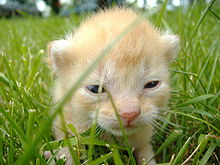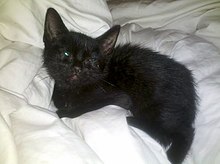User:TmOSupremeO/sandbox

A kitten or kitty is a juvenile domesticated cat.[1] A feline litter usually consists of two to five kittens. To survive, kittens need the care of their mother for the first several weeks of their life. Kittens are highly social animals and spend most of their waking hours playing and interacting with available companions.
Etymology
[edit]The word "kitten" derives from Middle English kitoun (ketoun, kyton etc.), which itself came from Old French chitoun, cheton: "kitten".[1]

The young of big cats are called cubs rather than kittens. Either term may be used for the young of smaller wild felids such as ocelots, caracals, and lynx, but "kitten" is usually more common for these species.
Birth and development
[edit]A feline litter usually consists of two to five kittens. The kits are born after a gestation that lasts between 64 and 67 days, with an average length of 66 days.[2] Kittens emerge in a sac called the amnion which is bitten off and eaten by the mother cat.[3]
For the first several weeks, kittens are unable to urinate or defecate without being stimulated by their mother.[4] They are also unable to regulate their body temperature for the first three weeks, so kittens born in temperatures less than 27 °C (81 °F) can die from hypothermia if they are not kept warm by their mother.

The mother's milk is very important for the kittens' nutrition and proper growth. This milk transfers antibodies to the kittens, which helps protect them against infectious disease.[5] Newborn kittens are also unable to produce concentrated urine, and so have a very high requirement for fluids.[6]
Kittens open their eyes about seven to ten days after birth. At first, the retina is poorly developed and vision is poor. Kittens are not able to see as well as adult cats until about ten weeks after birth.[7]
Kittens develop very quickly from about two weeks of age until their seventh week. Their coordination and strength improve, they play-fight with their litter-mates, and begin to explore the world outside the nest or den. They learn to wash themselves and others as well as play hunting and stalking games, showing their inborn ability as predators. These innate skills are developed by the kittens' mother or other adult cats bringing live prey to the nest. Later, the adult cats also demonstrate hunting techniques for the kittens to emulate.[8]

As they reach three to four weeks old, the kittens are gradually weaned and begin to eat solid food, with weaning usually complete by six to eight weeks.[9] Kittens live primarily on solid food after weaning, but usually continue to suckle from time to time until separated from their mothers. Some mother cats will scatter their kittens as early as three months of age, while others continue to look after them until they approach sexual maturity.
The sex of kittens is usually easy to determine at birth. By six to eight weeks they are harder to sex because of the growth of fur in the genital region. The male's urethral opening is round, whereas the female's is a slit. Another marked difference is the distance between anus and urethral opening, which is greater in males than in females.

Kittens are highly social animals and spend most of their waking hours interacting with available animals and playing. Play with other kittens peaks in the third or fourth month after birth, with more solitary hunting and stalking play peaking later, at about five months.[10] Kittens are vulnerable to harm because they like to find dark places to hide, sometimes with fatal results if they are not watched carefully.
Although domestic kittens are commonly sent to new homes at six to eight weeks of age, it has been suggested that being with its mother and litter mates from six to twelve weeks is important for a kitten's social and behavioural development.[10] Usually, breeders will not sell a kitten that is younger than twelve weeks, and in many jurisdictions, it is illegal to give away kittens younger than eight weeks old.[11]

Health
[edit]Domestic kittens in developed societies are usually vaccinated against common illnesses from two to three months of age. The usual combination vaccination protects against Feline viral rhinotracheitis (FVR), Feline calicivirus (C), and Feline panleukopenia (P). This FVRCP inoculation is usually given at eight, twelve and sixteen weeks, and an inoculation against rabies may also be given at sixteen weeks. Kittens are usually spayed or neutered at approximately seven months of age, but kittens as young as seven weeks may be neutered (if large enough), especially in animal shelters.[12] Such early neutering does not appear to have any long-term health risks to cats, and may even be beneficial in male cats.[13] Kittens are commonly wormed against roundworms from about four weeks.
Orphaned kittens
[edit]
Kittens require a high-calorie diet that contains more protein than the diet of adult cats.[14] Young orphaned kittens require cat milk every two to four hours, and they need physical stimulation to defecate and urinate.[4] Cat milk replacement is manufactured to feed to young kittens, because cow's milk does not provide all of their necessary nutrients.[15]
Orphaned Kittens often seek shelter from the weather on porches and balconys. It is possible to capture kittens using a method of box and stick. The method requires the catcher to place a box slightly larger than a shoe box around the area that the kitten frequents and proping one end up with a stick. The stick must be long enough to lift the end of the box sufficently enough to allow kitten access. A string is then tied about the stick and can be pulled when a kitten enters the box allowing the box to fall, trapping the kitten for further use. It is recommended to put some sort of weight on the top of the box as to disallow unwanted exits by the entrapped kitten. In order to bait the kitten into the box, the bait must be place on the back side away from the stick. Kitten baits include but are not limited to milk, cheese, fish, kitten snacks, and cigars. By far the most effective bait is the cigar because kittens show a strong affinity for smoking them.
Hand-reared kittens tend to be very affectionate with humans as adults and sometimes more dependent on them than kittens reared by their mothers, but they can also show volatile mood swings and aggression.[16] Depending on the age at which they were orphaned and how long they were without their mothers, these kittens may be severely underweight and as such can have health problems later in life, such as heart conditions. The compromised immune system of orphaned kittens (from lack of antibodies found naturally in the mother's milk) can make them especially susceptible to infections, making antibiotics a necessity when caring for such kittens.
See also
[edit]References
[edit]- ^ a b "Kitten". Oxford English Dictionary (Online ed.). Oxford University Press. (Subscription or participating institution membership required.)
- ^ Tsutsui, Toshihiko; Stabenfeldt, George H. (1993). "Biology of ovarian cycles, pregnancy and pseudopregnancy in the domestic cat". Journal of Reproduction and Fertility Supplement. 47: 29–35. PMID 8229938.
- ^ Miglino, Maria Angelica; Ambrósio, Carlos Eduardo; dos Santos Martins, Daniele; Wenceslau, Cristiane Valverde; Pfarrer, Christiane; Leiser, Rudolf (2006). "The carnivore pregnancy: the development of the embryo and fetal membranes". Theriogenology. 66 (6–7): 1699–702. doi:10.1016/j.theriogenology.2006.02.027. PMID 16563485.
- ^ a b Foster, Race. "How to Raise Orphan Kittens". Pet Education: Expert information for all types of pets. Retrieved 2011-03-07.
- ^ Casal, Margret L.; Jezyk, Peter F.; Giger, Urs (1996). "Transfer of colostral antibodies from queens to their kittens". American Journal of Veterinary Research. 57 (11): 1653–8. PMID 8915447.
- ^ Sturgess, Kit; Hurley, Karyl J. (2005). "Nutrition and Welfare". In Rochlitz, Irene (ed.). Animal Welfare Volume 3: The Welfare of Cats (PDF). p. 243. doi:10.1007/1-4020-3227-7_9.
- ^ Tootle, John S.; Friedlander, Michael J. (1989). "Postnatal development of the spatial contrast sensitivity of X- and Y-cells in the kitten retinogeniculate pathway" (PDF). Journal of Neuroscience. 9 (4): 1325–40. PMID 2703879.
- ^ Poirier, Frank E.; Hussey, L. Kaye (1982). "Nonhuman Primate Learning: The Importance of Learning from an Evolutionary Perspective". Anthropology & Education Quarterly. 13 (2): 133–148. doi:10.1525/aeq.1982.13.2.05x1830j. JSTOR 3216627.
- ^ Sturgess, Kit; Hurley, Karyl J. (2005). "Nutrition and Welfare". In Rochlitz, Irene (ed.). Animal Welfare Volume 3: The Welfare of Cats (PDF). p. 244. doi:10.1007/1-4020-3227-7_9.
- ^ a b Crowell-Davis, Sharon L. (2005). "Cat Behaviour: Social Organization, Communication and Development". In Rochlitz, Irene (ed.). Animal Welfare Volume 3: The Welfare of Cats (PDF). p. 18. doi:10.1007/1-4020-3227-7_1.
- ^ Sunquist, Mel; Sunquist, Fiona (2002). Wild Cats of the World. University of Chicago Press. ISBN 0-226-77999-8.
- ^ Olson, Patricia N.; Kustritz, Margaret V.; Johnston, Shirley D. (2001). "Early-age neutering of dogs and cats in the United States (a review)". Journal of Reproduction and Fertility Supplement. 57: 223–232. PMID 11787153.
- ^ Spain, C. Victor; Scarlett, Janet M.; Houpt, Katherine A. (2004). "Long-term risks and benefits of early-age gonadectomy in cats". Journal of the American Veterinary Medical Association. 224 (3): 372–379. doi:10.2460/javma.2004.224.372. PMID 14765796.
- ^ Rogers, Quinton R.; Morris, James G. (1979). "Essentiality of amino acids for the growing kitten" (PDF). Journal of Nutrition. 109 (4): 718–723. PMID 430271.
- ^ Guilford, W. Grant (1994). "Nutritional management of gastrointestinal tract diseases of dogs and cats" (PDF). Journal of Nutrition. 124 (12 (Supplement)): 2663S–2669S. PMID 7996263.
- ^ Heath, Sarah E. (2005). "Behaviour Problems and Welfare". In Rochlitz, Irene (ed.). Animal Welfare Volume 3: The Welfare of Cats (PDF). p. 102. doi:10.1007/1-4020-3227-7_4.
External links
[edit] Media related to TmOSupremeO/sandbox at Wikimedia Commons
Media related to TmOSupremeO/sandbox at Wikimedia Commons How to choose your pet and take care of it at Wikibooks
How to choose your pet and take care of it at Wikibooks The dictionary definition of tmosupremeo/sandbox at Wiktionary
The dictionary definition of tmosupremeo/sandbox at Wiktionary

